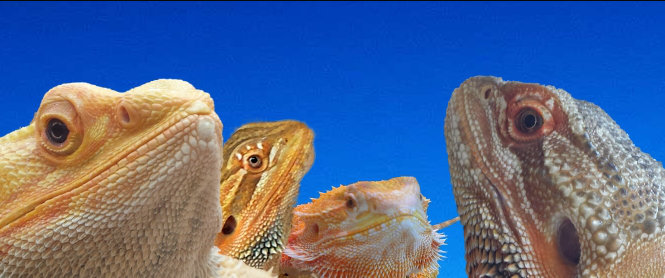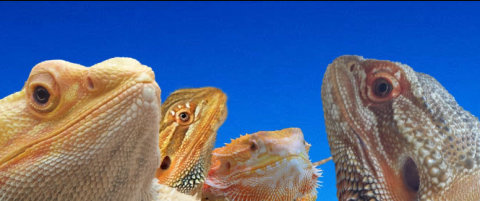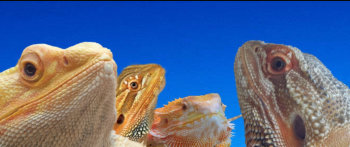

Over the last twenty years or so
the Bearded Dragon, or as it is
correctly known the Inland or
Central Bearded Dragon has leg
waved and head bobbed itself
into reptile keepers affections all
round world.
Bearded Dragons are a medium
sized lizard allowing easy if
occasionally spiky handling.

© Steladragons.co.uk

Steladragons.co.uk

Bearded Dragon Habitat
Habitat
A wooden vivarium is the ideal home for your Bearded Dragon, 3ft in length will be suitable for your new baby but they quickly grow and a size of 4ft by 2ft by 2ft high is recommended for adults where possible. Dragons should be housed on their own, males will fight, a lot of females do too and pairs should only be put together for breeding and then separated again otherwise the female’s health can be affected. It is worth knowing before you commit to buying a pair of babies, you will need a second setup at around 5 – 6 month old. There have been many debates on the best substrate to use for Beardies as many common ones such as woodchip or sand Inc calci-sand can cause impaction and possibly death, but we use and recommend lino or tiles (non-slip of course). You will need a 10-12% full scale UVB tube a foot shorter than your vivarium and a starter unit to power it, for babies hang this from the back wall of your viv about halfway up and for adults from the top, a reflector will increase the output and is also recommended, the UVB is needed to help prevent MBD. A basking spotlight above a basking rock or log in the hot end of the vivarium and another rock or piece of wood along with a bowl for greens in the cooler end is sufficient furnishing but for adults branches to climb and sit on with fake plants can be added, but remember all the decorations will need to be cleaned on a regular basis so bear this in mind when selecting the décor. Digital thermometers should be placed at either end of the vivarium to ensure ideal temperatures of 80-85f at the cool end and 90-95f at the hot end of your viv with a basking spot of around 105f (babies prefer 110-115f), use a dimmer to ensure these temperatures do not fluctuate too much. Lights should be on 12-14 hours a day and household temperatures are fine overnight. In winter 8-10 hours of lighting and night time temperatures no lower than 70f are best, this can be managed if need be with a ceramic heat bulb which emits no light to disturb your pet, this should be controlled by either and on/off or pulse thermostat You should never use a heat mat within a Beardie enclosure, they detect light and therefore their heat source from above with a 'third eye' on top of their head not their tummies so will sit on a hot mat until they burn themselves externally and internally.

Over the last twenty years or so the Bearded Dragon, or as it is
correctly known the Inland or Central Bearded Dragon has leg
waved and head bobbed itself into reptile keepers affections
all round world.
Bearded Dragons are a medium sized lizard allowing easy if
occasionally spiky handling.

© Steladragons.co.uk

Steladragons.co.uk

Bearded Dragon Habitat
Habitat
A wooden vivarium is the ideal home for your Bearded Dragon, 3ft in length will be suitable for your new baby but they quickly grow and a size of 4ft by 2ft by 2ft high is recommended for adults where possible. Dragons should be housed on their own, males will fight, a lot of females do too and pairs should only be put together for breeding and then separated again otherwise the female’s health can be affected. It is worth knowing before you commit to buying a pair of babies, you will need a second setup at around 5 – 6 month old. There have been many debates on the best substrate to use for Beardies as many common ones such as woodchip or sand Inc calci-sand can cause impaction and possibly death, but we use and recommend lino or tiles (non-slip of course). You will need a 10-12% full scale UVB tube a foot shorter than your vivarium and a starter unit to power it, for babies hang this from the back wall of your viv about halfway up and for adults from the top, a reflector will increase the output and is also recommended, the UVB is needed to help prevent MBD. A basking spotlight above a basking rock or log in the hot end of the vivarium and another rock or piece of wood along with a bowl for greens in the cooler end is sufficient furnishing but for adults branches to climb and sit on with fake plants can be added, but remember all the decorations will need to be cleaned on a regular basis so bear this in mind when selecting the décor. Digital thermometers should be placed at either end of the vivarium to ensure ideal temperatures of 80-85f at the cool end and 90-95f at the hot end of your viv with a basking spot of around 105f (babies prefer 110-115f), use a dimmer to ensure these temperatures do not fluctuate too much. Lights should be on 12-14 hours a day and household temperatures are fine overnight. In winter 8-10 hours of lighting and night time temperatures no lower than 70f are best, this can be managed if need be with a ceramic heat bulb which emits no light to disturb your pet, this should be controlled by either and on/off or pulse thermostat You should never use a heat mat within a Beardie enclosure, they detect light and therefore their heat source from above with a 'third eye' on top of their head not their tummies so will sit on a hot mat until they burn themselves externally and internally.

Over the last twenty years or so
the Bearded Dragon, or as it is
correctly known the Inland or
Central Bearded Dragon has leg
waved and head bobbed itself
into reptile keepers affections all
round world.
Bearded Dragons are a medium
sized lizard allowing easy if
occasionally spiky handling.

© Steladragons.co.uk














